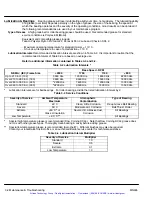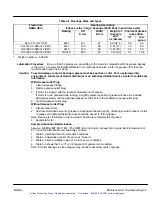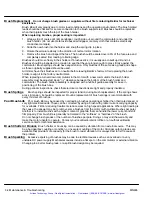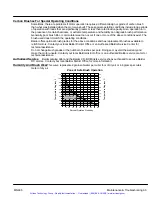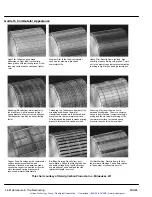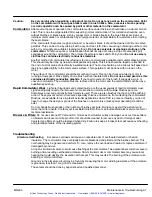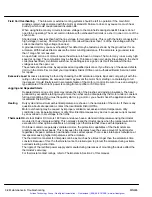
General Information 1-3
MN605
Caution:
Do not lift the motor and its driven load by the motor lifting hardware. The motor lifting hardware
is adequate for lifting only the motor. Disconnect the load from the motor shaft before moving the
motor.
Handling
The motor should be lifted using the lifting lugs or eye bolts provided.
1. Use the lugs or eye bolts provided to lift the motor. Never attempt to lift the motor and additional
equipment connected to the motor by this method. The lugs or eye bolts provided are designed to lift
only the motor. Never lift the motor by the motor shaft or the hood of a WPII motor. If eye bolts are
used for lifting a motor, be sure they are securely tightened. The lifting direction should not exceed a
20
°
angle from the shank of the eye bolt. Excessive lifting angles can cause motor damage.
2. To avoid condensation inside the motor, do not unpack until the motor has reached room temperature.
(Room temperature is the temperature of the room in which it will be installed).
The packing provides insulation from temperature changes during transportation.
3. When lifting a WPII (Weather Proof Type 2) motor, do not lift the motor by inserting lifting lugs into
holes on top of the cooling hood. These lugs are to be used for hood removal only.
A spreader bar should be used to lift the motor by the cast lifting lugs located on the motor frame.
4. If the motor must be mounted to a plate with the driven equipment such as pump, compressor etc.,
it may not be possible to lift the motor alone. For this case, the assembly should be lifted by a sling
around the mounting base. The entire assembly can be lifted as an assembly for installation.
Do not lift the assembly using the motor lugs or eye bolts provided. Lugs or eye bolts are designed to
lift motor only. If the load is unbalanced (as with couplings or additional attachments) additional slings
or other means must be used to prevent tipping. In any event, the load must be secure before lifting.
Storage
Storage requirements for motors and generators that will not be placed in service for at least six months
from date of shipment. To avoid condensation inside the motor, do not unpack until the motor has
reached room temperature. (Room temperature is the temperature of the room in which it will be
installed). The packing provides insulation from temperature changes during transportation.
Improper motor storage will result in seriously reduced reliability and failure. An electric motor that does
not experience regular usage while being exposed to normally humid atmospheric conditions is likely to
develop rust or rust particles on surrounding surfaces to contaminate the bearings. The electrical
insulation may absorb an excessive amount of moisture leading to the motor winding failure.
A wooden crate “shell” should be constructed to secure the motor during storage. This is similar to an
export box but the sides & top must be secured to the wooden base with lag bolts (not nailed as export
boxes are) to allow opening and reclosing many times without damage to the “shell”.
Preparation for Storage
1. Some motors have a shipping brace attached to the shaft to prevent damage during transportation.
The shipping brace, if provided, must be removed and stored for future use. The brace must be
reinstalled to hold the shaft firmly in place against the bearing before the motor is moved.
2. Store in the original containers in a clean, dry, protected warehouse where these controlled:
a. Shock or vibration must not exceed 2 mils maximum at 60 hertz, to prevent the bearings from
brinelling. If shock or vibration exceeds this limit vibration isolation pads must be used.
b. Storage temperatures of 10
°
C (50
°
F) to 49
°
C (120
°
F) must be maintained.
c. Relative humidity must not exceed 60%.
d. Motor space heaters (optional) are to be connected and energized whenever there is a possibility
that the storage ambient conditions will reach the dew point. Space heaters are optional.
Note: Remove motor from containers when heaters are energized, reprotect if necessary.
3. Measure and record the resistance of the winding insulation every 30 days of storage.
a. If motor insulation resistance decreases to less than 5 Meg ohms, contact your Baldor District
office.
b. Place new desiccant inside the vapor bag and re
−
seal by taping it closed.
c. If a zipper
−
closing type bag is used instead of the heat
−
sealed type bag, zip the bag closed
instead of taping it. Be sure to place new desiccant inside bag after each monthly inspection.
d. Place the shell over the motor and secure with lag bolts.
4. Where motors are mounted to machinery, the mounting must be such that the drains and breathers
are fully operable and are at the lowest point of the motor. Vertical motors must be stored in the
vertical position. Storage environment must be maintained as stated in step 2.
Artisan Technology Group - Quality Instrumentation ... Guaranteed | (888) 88-SOURCE | www.artisantg.com

















